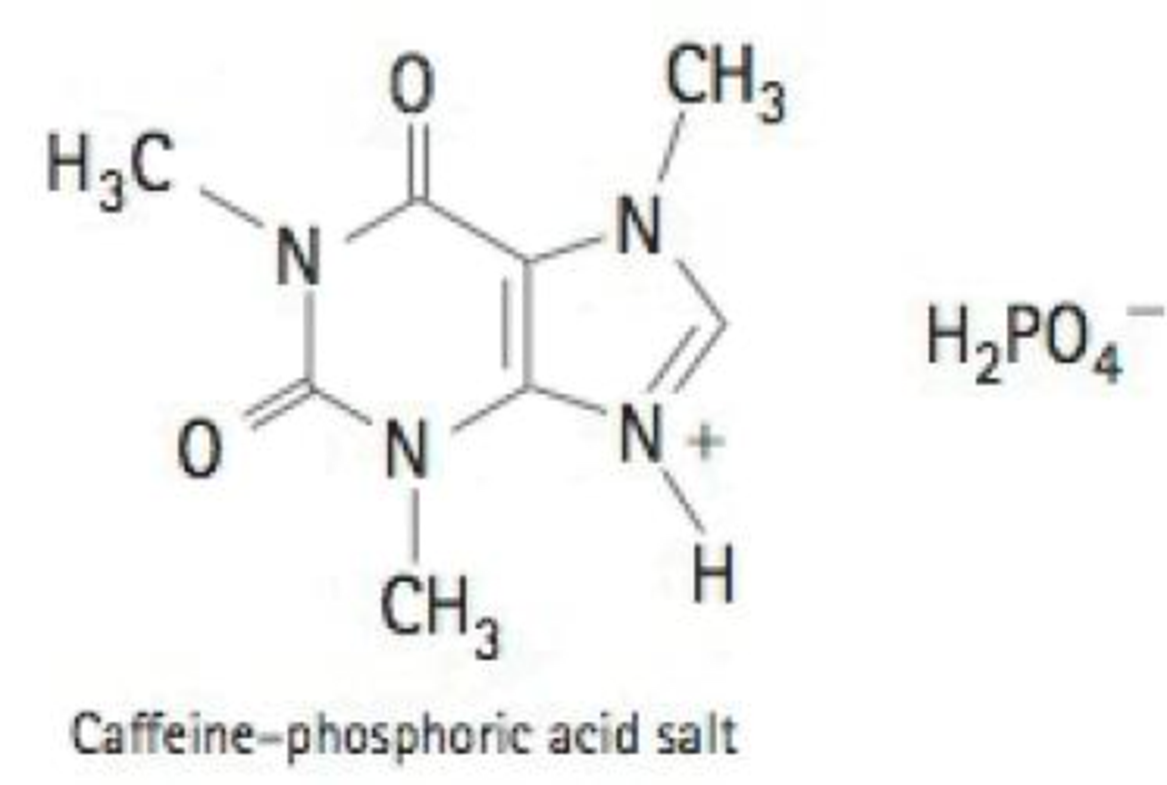
Conceptual Physical Science (6th Edition)
6th Edition
ISBN: 9780134060491
Author: Paul G. Hewitt, John A. Suchocki, Leslie A. Hewitt
Publisher: PEARSON
expand_more
expand_more
format_list_bulleted
Textbook Question
Chapter 19, Problem 58E
The phosphoric acid salt of caffeine has the structure

This molecule behaves as an acid in that it can donate a hydrogen ion, created from the hydrogen atom bonded to the positively charged nitrogen atom. What are all the products formed when 1 mole of this salt reacts with 1 mole of sodium hydroxide, NaOH, a strong base?
Expert Solution & Answer
Want to see the full answer?
Check out a sample textbook solution
Students have asked these similar questions
Plants grow in many different shapes and sizes. Much of their shape depends on an internal structure that is composed of
carbon-containing molecules such as cellulose and lignin. Plants that have a strong internal structure can grow larger than other
plants because their structure can support their size.
Plants obtain the majority of the carbon necessary for building these structural molecules from -
O air
O microorganisms
O soil
O water
10
11
12
13
14
15 16 17
18
19
20
近
:
P
Note: You may assume you have an excess of either reactant if the reaction requires more than one of those molecules to form the products.
In the drawing area below, draw the skeletal ("line") structures of the missing organic products X and Y. You may draw the structures in any arrangement that
you like, so long as they aren't touching.
H+
H+
+ -OH
☑
Y
Predict the organic products that form in the reaction below:
Click and drag to start drawing a
structure.
Indicate the relationship between the two structures in the pair. Are they chair conformations of the same
molecule? If so, are they conformational diastereomers, conformational enantiomers, or identical? If they are
not conformations of the same molecule, what is their stereochemical relationship?
CH3
CH3
CH3
H3C
CH3
H3C
CH3
They are chair conformations of the same molecule, and they are conformational diastereomers.
They are chair conformations of the same molecule, and they are conformational enantiomers.
They are identical conformations of the same molecule.
They are different molecules, and they are diastereomers.
They are different molecules, and they are enantiomers.
O000
Chapter 19 Solutions
Conceptual Physical Science (6th Edition)
Ch. 19 - How do two structural isomers differ from each...Ch. 19 - How are two structural isomers similar to each...Ch. 19 - What physical property of hydrocarbons is used in...Ch. 19 - What types of hydrocarbons are more abundant in...Ch. 19 - To how many atoms is a saturated carbon atom...Ch. 19 - What is the difference between a saturated...Ch. 19 - How many multiple bonds must a hydrocarbon have in...Ch. 19 - What kind of ring do aromatic compounds contain?Ch. 19 - What is a heteroatom?Ch. 19 - Why do heteroatoms make such a difference in the...
Ch. 19 - Why are low-formula-mass alcohols soluble in...Ch. 19 - What distinguishes an alcohol from a phenol?Ch. 19 - What distinguishes an alcohol from an ether?Ch. 19 - Which heteroatom is characteristic of an amine?Ch. 19 - Do amines tend to be acidic, neutral, or basic?Ch. 19 - Are alkaloids found in nature?Ch. 19 - What are some examples of alkaloids?Ch. 19 - Which elements make up the carbonyl group?Ch. 19 - How are ketones and aldehydes related to each...Ch. 19 - How are amides and carboxylic acids related to...Ch. 19 - From what naturally occurring compound is aspirin...Ch. 19 - What happens to the double bond of a monomer...Ch. 19 - What is released in the formation of a...Ch. 19 - Why is plastic wrap made of polyvinylidene...Ch. 19 - Prob. 25RCQCh. 19 - Rank the following molecules in order of the phase...Ch. 19 - Rank the following hydrocarbons in order of...Ch. 19 - Rank the following hydrocarbons in order of...Ch. 19 - Rank the following organic molecules in order of...Ch. 19 - Rank the following organic molecules in order of...Ch. 19 - What property of carbon allows for the formation...Ch. 19 - Why does the melting point of hydrocarbons...Ch. 19 - Draw all the structural isomers for hydrocarbons...Ch. 19 - How many structural isomers are shown here?Ch. 19 - According to Figure 19.3, which has the higher...Ch. 19 - The temperatures in a fractionating tower at an...Ch. 19 - Prob. 40ECh. 19 - Do heavier hydrocarbons tend to produce more or...Ch. 19 - What do these two structures have in common?Ch. 19 - What do the compounds cyclopropane and propene...Ch. 19 - What are the chemical formulas for the following...Ch. 19 - Prob. 45ECh. 19 - Prob. 46ECh. 19 - Identify the following functional groups in this...Ch. 19 - What must be added to a double bond to transform...Ch. 19 - What do phenols and carboxylic acids have in...Ch. 19 - What is the difference between a ketone and an...Ch. 19 - Prob. 51ECh. 19 - Prob. 52ECh. 19 - What is the percent volume of water in 80-proof...Ch. 19 - One of the skin-irritating components of poison...Ch. 19 - Cetyl alcohol, C16H34O, is a common ingredient of...Ch. 19 - A common inactive ingredient in products such as...Ch. 19 - A common inactive ingredient in products such as...Ch. 19 - The phosphoric acid salt of caffeine has the...Ch. 19 - Prob. 59ECh. 19 - In water, does the following molecule act as an...Ch. 19 - If you saw the label phenylephrine-HCl on a...Ch. 19 - The amino acid lysine is shown below. What...Ch. 19 - Prob. 63ECh. 19 - Suggest an explanation why aspirin has a sour...Ch. 19 - Benzaldehyde is a fragrant oil. If stored in an...Ch. 19 - What products are formed upon the reaction of...Ch. 19 - The disodium salt of ethylenediaminetetraacetic...Ch. 19 - Would you expect polypropylene to be more dense or...Ch. 19 - Hydrocarbons release a lot of energy when ignited....Ch. 19 - The polymer styrene-butadiene rubber (SBR), shown...Ch. 19 - Citral and camphor are both 10-carbon odoriferous...Ch. 19 - Many of the natural product molecules synthesized...Ch. 19 - The solvent diethyl ether can be mixed with water...Ch. 19 - Alkaloid salts are not very soluble in the organic...Ch. 19 - Why does the melting point of hydrocarbons...Ch. 19 - How many structural isomers are there for...Ch. 19 - Which contains more hydrogen atoms: a five-carbon...Ch. 19 - Prob. 4RATCh. 19 - Why might a high-formula-mass alcohol be insoluble...Ch. 19 - Alkaloid salts are not very soluble in the organic...Ch. 19 - Explain why caprylic acid, CH3(CH2)6 COOH,...Ch. 19 - How many oxygen atoms are bonded to the carbon of...Ch. 19 - One solution to the problem of our overflowing...Ch. 19 - Which would you expect to be more viscous: a...
Additional Science Textbook Solutions
Find more solutions based on key concepts
What is the voltage across the open switch in Figure 21.43?
College Physics
(III) A ball is dropped from the top of a 50.0-m-high cliff. At the same time, a carefully aimed stone is throw...
Physics for Scientists and Engineers with Modern Physics
3. What is free-fall, and why does it make you weightless? Briefly describe why astronauts are weightless in th...
The Cosmic Perspective (8th Edition)
8. A security guard walks at a steady pace, traveling 110 m in one trip around the perimeter of a building. It ...
College Physics: A Strategic Approach (4th Edition)
20.1 A diesel engine performs 2200 J of mechanical work and discards 4300 J of heat each cycle. (a) How much he...
University Physics with Modern Physics (14th Edition)
Knowledge Booster
Learn more about
Need a deep-dive on the concept behind this application? Look no further. Learn more about this topic, physics and related others by exploring similar questions and additional content below.Similar questions
- How many shared pairs of electrons are in an ammonia molecule NH3? (12.5) (a) 1 (b) 2 (c) 3 (d) 4arrow_forwardHow many products including stereoisomers are formed when 1,1,3,3- tetramethylcyclobutane undergoes monochlorination Determine the structure of the major monochlorination product of 1,1,3,3- tetramethylcyclobutane shown below using the reactivity order 5 : 3.5 : 1 for tertiary : secondary : primary hydrogens respectively.arrow_forwardMango lemonade tea consists of several substances that are NOT chemically combined, so Mango lemonade tea is classified as anarrow_forward
- Which of the following statements are true with regards to alkanes, alkenes, and alkynes? Select all that apply. They are all hydrocarbons Alkanes have one or more double covalent bonds between carbon atoms Alkenes have one or more double covalent bonds between carbon atoms. Alkynes have one or more triple covalent bond between carbon atoms. O Alkenes have one or more double bond between either two carbon atoms, or a carbon and hydrogen atom.arrow_forwardYour friend refuses to use the coffee creamers at the local diner because they have been sitting on the table all day. Explain to your friend why these creamers are perfectly safe to use.arrow_forwardJustin is making a snack. He toasts a piece of bread and spreads peanut butter and jelly on it. Then he cuts an apple into several slices and adds these to his plate. Next, Justin mixes a scoop of lemonade powder into a glass of water, mixes it, and adds ice. How many chemical changes occurred in this scenario?arrow_forward
- Hello, I am having an issue with figuring the following: For pH 9.5 I am getting 3.16 x 10 ^-10. Is this correct? Thank you Solution X has a pH of 9.5, and solution Y has a pH of 7.6.? What is [H3O+] in Solution X? What is [H3O+] in Solution Y?arrow_forwardAscorbic acid (vitamin C) is oxidized by iodine according to the equation below: 1 mol ascorbic acid + 1 mol iodine1 mol dehydroascorbic acid + 2 mol hydroiodic acid a) An iodine solution of unknown concentration is used to titrate 10.00 mL of 0.003013 M ascorbic acid. If 27.55 mL of iodine is required to reach the endpoint, what is the concentration of the iodine solution? Express as a decimal.arrow_forwardThe acidity or alkalinity of a solution is defined by pH = –log[H+] where [H+] is the hydrogen ion concentration, measured in moles per liter. Solutions with a pH value of less than 7 are acidic; solutions with a pH value of greater than 7 are basic and solutions with a pH of 7 (such as pure water) are neutral. a) Suppose that you test apple juice and find that the hydrogen ion concentration is [H+] = 0.0003. Find the pH value and determine whether the juice is basic or acidic.arrow_forward
- What variables do you think are needed to determine the effectiveness of the antifreeze?arrow_forwardJustify the statement: Polymer molecular weight is expressed in terms of an average. Calculatethe number average and weight average molecular weights of polymer molecules with different degrees of polymerization such as 300, 550, 750 and 900 that are mixed in a molecular ratio 1: 2: 3: 4 in a sample of high polymer of styrene(C6H5 CH= CH2).arrow_forwardWrite the cell notation for a voltaic cell with the following half-reaction. Al(s) → Ae3+ 2H*(aq) + 2e → Afs*(aq) + 3e → H2(g)arrow_forward
arrow_back_ios
arrow_forward_ios
Recommended textbooks for you
 An Introduction to Physical SciencePhysicsISBN:9781305079137Author:James Shipman, Jerry D. Wilson, Charles A. Higgins, Omar TorresPublisher:Cengage Learning
An Introduction to Physical SciencePhysicsISBN:9781305079137Author:James Shipman, Jerry D. Wilson, Charles A. Higgins, Omar TorresPublisher:Cengage Learning


An Introduction to Physical Science
Physics
ISBN:9781305079137
Author:James Shipman, Jerry D. Wilson, Charles A. Higgins, Omar Torres
Publisher:Cengage Learning
The Laws of Thermodynamics, Entropy, and Gibbs Free Energy; Author: Professor Dave Explains;https://www.youtube.com/watch?v=8N1BxHgsoOw;License: Standard YouTube License, CC-BY